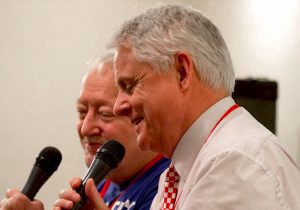 I can’t believe it’s already March, just where has the time gone? I suppose a trip to Athlone to attend the Amiga Ireland 2018 Meetup in mid January helped to soak up some of the time. 😉 Once again, Jarlath and his crew made us feel very welcome, although the stories of drinking horse’s milk took on an entirely new meaning thanks to a few pints of Guinness and some good Amiga company (MsMadLemon you know who you are).
I can’t believe it’s already March, just where has the time gone? I suppose a trip to Athlone to attend the Amiga Ireland 2018 Meetup in mid January helped to soak up some of the time. 😉 Once again, Jarlath and his crew made us feel very welcome, although the stories of drinking horse’s milk took on an entirely new meaning thanks to a few pints of Guinness and some good Amiga company (MsMadLemon you know who you are). 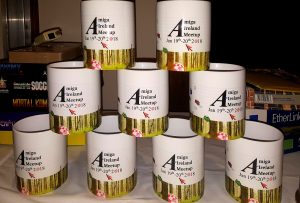 David Pleasance, former Commodore Managing Director and I gave a couple joint Q&A sessions and during one of them I talked about the special bond that we all share as Commodore and Amiga enthusiasts, which without all of us keeping the dream alive there would be no Amiga. Kenny Gaughan recorded my “We are Amiga” comments and posted them on his Sensible Blogger YouTube channel. I was quite pleased with myself, thinking I had invented a new inspirational Amiga slogan on the spur of the moment but, on checking later, I found someone else had already beaten me to it a few years ago! Such is life. 😉 However, while I was in Europe I managed a quick side trip to AmigaKit’s offices in Cardiff to pick up a shiny new motherboard to take back with me to New Zealand.
David Pleasance, former Commodore Managing Director and I gave a couple joint Q&A sessions and during one of them I talked about the special bond that we all share as Commodore and Amiga enthusiasts, which without all of us keeping the dream alive there would be no Amiga. Kenny Gaughan recorded my “We are Amiga” comments and posted them on his Sensible Blogger YouTube channel. I was quite pleased with myself, thinking I had invented a new inspirational Amiga slogan on the spur of the moment but, on checking later, I found someone else had already beaten me to it a few years ago! Such is life. 😉 However, while I was in Europe I managed a quick side trip to AmigaKit’s offices in Cardiff to pick up a shiny new motherboard to take back with me to New Zealand.

Towering Achievements
Over the past few months I’ve had fun helping to test beta versions of Daniel Müßener’s Amiga based port of Tower 57, a dystopian, steampunk top-down shooter game with 16-bit inspired pixel art and destructible environments being developed by Pixwerk. Although the game was being developed for PC, Mac & Linux machines additional stretch goals were included for game ports to AmigaOS4, MorphOS and AROS. I backed the Kickstarter campaign in the hope that the stretch goals would be achieved and fortunately the campaign raised enough funds to realise this aim. Daniel Müßener took on the task of creating the Amiga ports and has worked really hard to make the Amiga version very special indeed. The PC and Mac versions were officially released in November last year and, as a Kickstater backer, I’ve played the game on Steam on my PC. Yes I actually have a PC. 😉 However, I have to say Daniel’s Amiga ports are very impressive. Using his advanced coding skills he has gone above and beyond in his attempts to optimise the game making it eminently playable, even on least powerful machines. He provided a special benchmark reference saved game to show how his Tower57 game port staked up against the official Steam release.
As I have a few Next-Generation Amiga machines (*understatement*) I decided to perform some of my own Tower57 benchmarks. 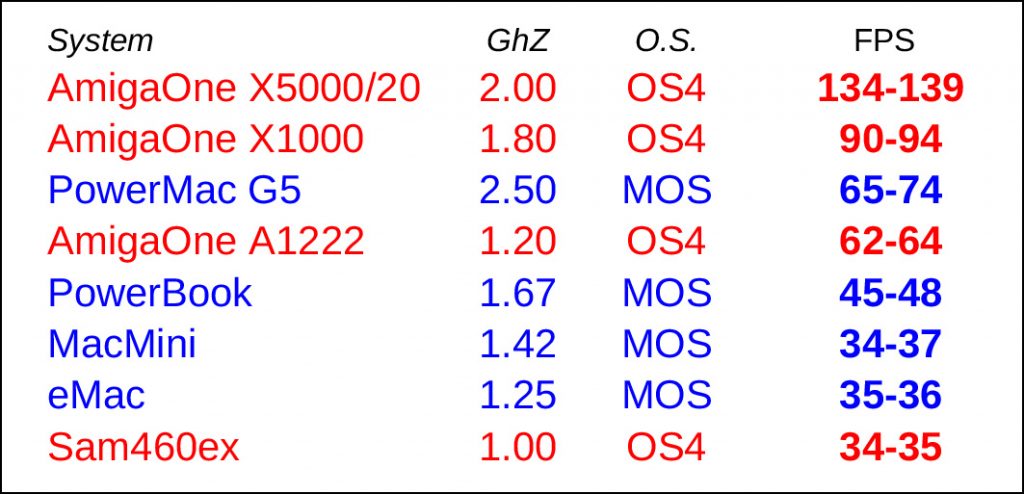 Although as I have often said, I’m not a great fan of benchmarks, it was good to be able to test the Amiga Next-Generation systems against mainstream computers. The results are quite remarkable. Unfortunately, I could not get the AROS version to run on my machine because I need to update my version of Icaros Desktop, a job I put aside for another day. Fortunately I have a good selection of AmigaOS and MorphOS machines to keep me busy. I used the full true colour version of Tower 57 rather than the reduced 16-bit version for lower powered machines for my benchmark comparisons. The model of graphic card also has an effect on the frames per second (fps) performance of Tower57. As you might expect, more powerful graphics cards produce better results. So in all of the tests with my AmigaOne machines, I used a middish-upper range passively cooled 1Gb Radeon HD7750 graphics card. All of the MorphOS based Apple machines used the standard built-in graphics cards they were supplied with.
Although as I have often said, I’m not a great fan of benchmarks, it was good to be able to test the Amiga Next-Generation systems against mainstream computers. The results are quite remarkable. Unfortunately, I could not get the AROS version to run on my machine because I need to update my version of Icaros Desktop, a job I put aside for another day. Fortunately I have a good selection of AmigaOS and MorphOS machines to keep me busy. I used the full true colour version of Tower 57 rather than the reduced 16-bit version for lower powered machines for my benchmark comparisons. The model of graphic card also has an effect on the frames per second (fps) performance of Tower57. As you might expect, more powerful graphics cards produce better results. So in all of the tests with my AmigaOne machines, I used a middish-upper range passively cooled 1Gb Radeon HD7750 graphics card. All of the MorphOS based Apple machines used the standard built-in graphics cards they were supplied with.
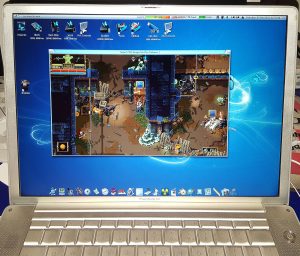
It’s probably no surprise that the AmigaOne X5000/20 comes out on top by quite a margin. The AmigaOne X1000 was no slowcoach either and pushed the G5 PowerMac into third place in my tests. It was also really good to see the AmigaOne A1222 giving the 2.5 Ghz PowerMac a run for its money. However, the really good news is that all of the Amiga Next-generation machines compared favourably with the commercial Steam release and were all very playable. Now what was that about benchmarks? I’ve always absolutely believed in them! 😉
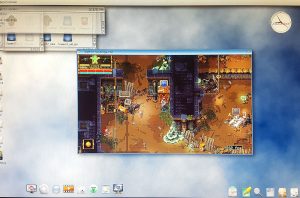
The good news is that Daniel has now officially released the game for all Next-Generation Amiga systems so there is no excuse for not trying out the game yourself. Even better, Daniel has now included an auto-updater which checks online to see if a new version of the game is available for your hardware. If it is, you have the option of downloading the Tower57 executable. If you don’t have a suitable Next-Generation machine (shame on you ;-)) you can always try out the Steam version on a PC.
Read all about it!
I finally received my copy of Commodore The Amiga Years book by Brian Bagnall. Having contributed to the original Kickstarter project I was a little peeved to see the book for sale on Amazon four months ago and long before I received my Kickstarter reward package. In fact some of the attendees at Amiwest 2017 in October last year already had a copy of the book. Brian did post an apology to all Kickstarter backers which read, “The one painful part of this for me is that places like Amazon got the book before you, the backers. I’ll trace back how this happened right to the start. As you might guess, the book printer prints all the books at the same time. They won’t print your Kickstarter books first, then print the books for the public at a later time (two book printings would be inefficient and excessively costly).” Anyway, enough of my moaning.
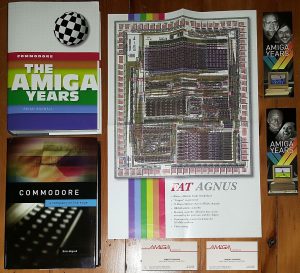
My Kickstarter pledge level entitled me to several eBooks and I received the download link on Christmas Eve, which was a nice present. In late January I finally received my signed copy of the book and a number of extra goodies including another copy of his earlier Commodore book, a FAT Agnus poster, two nice Amiga Years bookmarks and a couple of Amiga Corporation business cards revealing me as the Director of Hardware Engineering. OK Brian you are forgiven! 😉
I suppose the real question is: was the book worth the wait? I read Brian’s original book, On the Edge – The Spectacular Rise and Fall of Commodore when it was first released way back in 2005. So thirteen years on does his latest book, which concentrates on Commodore’s Amiga years, but not necessarily just the Amiga of course, provide any more information compared to his original book. If you go by the number of pages one would have to say it certainly does.
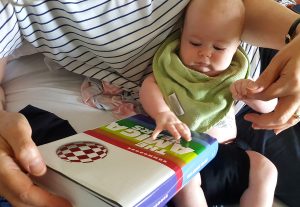
He has split the Amiga years into two volumes, the first of which is just over 500 pages and covers the period 1984 to 1987. Assuming the second volume, entitled The Final Years, is a similar length, then this is almost double the length of the original On the Edge book which was approximately 560 pages and covered the period 1974 – 1998, including a short one page prologue about Jack Tramiel. Irrespective of the length of the book, the important question that needs to be answered: is the book worth reading? Like Brian’s original book, it is very well researched, contains lots of first hand interviews and inspiring stories and should appeal to anyone who has an interest in Commodore and the Amiga. If you did not participate in the Kickstarter campaign you can still order the book from Amazon.
Talking about Commodore books, David Pleasance will soon be releasing his own inside story of his life and times at Commodore. His book, entitled Commodore : The Inside Story was funded by another Kickstarter backed campaign.  David spent 12 years at Commodore in several senior managerial and international roles. He has promised to reveal all the dark secrets behind the company that dominated the 8-bit computer revolution, created the world’s best selling personal computer and launched the revolutionary Amiga before declaring bankruptcy in 1994. His book was originally intended to be his own true recollections of his time at Commodore but the project has grown and now includes chapters from other key Commodore individuals who have promised to share their own personal Commodore tales. Again if you did not contribute the original Kickstarter campaign don’t despair, you can still pre-order a copy of the book directly from David’s website.
David spent 12 years at Commodore in several senior managerial and international roles. He has promised to reveal all the dark secrets behind the company that dominated the 8-bit computer revolution, created the world’s best selling personal computer and launched the revolutionary Amiga before declaring bankruptcy in 1994. His book was originally intended to be his own true recollections of his time at Commodore but the project has grown and now includes chapters from other key Commodore individuals who have promised to share their own personal Commodore tales. Again if you did not contribute the original Kickstarter campaign don’t despair, you can still pre-order a copy of the book directly from David’s website.
Polaris – the Amiga’s new North Star
Commonly known as the North or Pole star, Polaris is the brightest star in the constellation of Ursa Minor and is located almost at the North Celestial Pole, the point in the sky where all the stars seen from the Northern Hemisphere appear to rotate. Actually, the North Star is not a single star but a combination of several stars which add to its brightness and was used by early explorers in the Northern Hemisphere for navigation.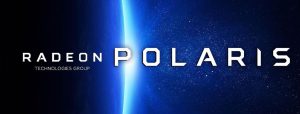 It’s probably quite apt that AMD called its 4th generation graphics architecture Polaris and produces a series of graphics cards in its Radeon RX 400 & 500 range. Even SONY’s PS4 Pro is powered by Polaris graphics technology. With graphics card technology advancing so fast in the mainstream computing world, AMD’s Radeon Southern Island graphics cards were rapidly becoming obsolete and difficult to find. Even the newer Oland based Radeon R7 240 variants are becoming increasingly scarce. In order to have a supply of readily available cards for our new AmigaOne hardware it was vitally important to create drivers for the Polaris based Radeon RX cards as soon as possible.
It’s probably quite apt that AMD called its 4th generation graphics architecture Polaris and produces a series of graphics cards in its Radeon RX 400 & 500 range. Even SONY’s PS4 Pro is powered by Polaris graphics technology. With graphics card technology advancing so fast in the mainstream computing world, AMD’s Radeon Southern Island graphics cards were rapidly becoming obsolete and difficult to find. Even the newer Oland based Radeon R7 240 variants are becoming increasingly scarce. In order to have a supply of readily available cards for our new AmigaOne hardware it was vitally important to create drivers for the Polaris based Radeon RX cards as soon as possible.
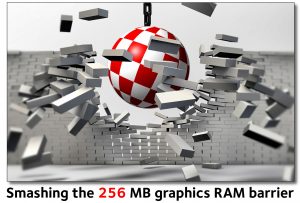 We are really fortunate to have a talented developer like Hans de Ruiter working on projects for A-EON Technology. For the past six months he has been hard at work creating the new Radeon RX graphics driver for AmigaOS 4.1 to support our AmigaOne hardware. It has been a long and difficult task and, as Matthew Leaman commented, made more difficult by “non-existent hardware documentation and endianess issues.”
We are really fortunate to have a talented developer like Hans de Ruiter working on projects for A-EON Technology. For the past six months he has been hard at work creating the new Radeon RX graphics driver for AmigaOS 4.1 to support our AmigaOne hardware. It has been a long and difficult task and, as Matthew Leaman commented, made more difficult by “non-existent hardware documentation and endianess issues.”
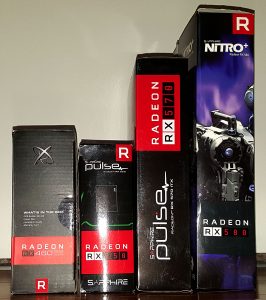
After a number of beta test releases, Hans has now issued version 1.6 of the RX driver to the Enhancer Software beta-test team. This is the pre-release version which has full 2D hardware acceleration and compositing implemented.
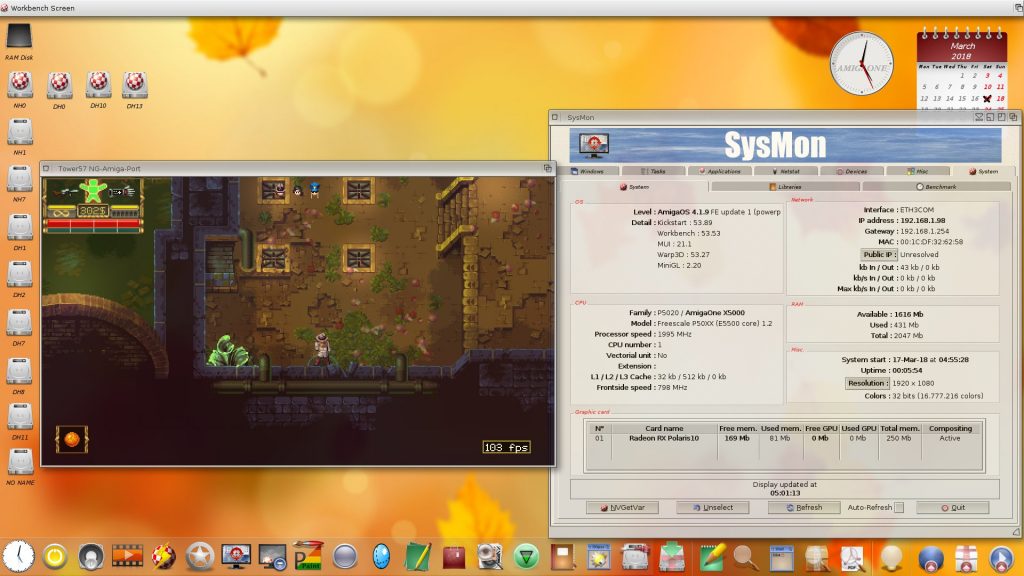
As a double test, I installed a Radeon RX580 (Polaris) card in my AmigaOne X5000 and ran the Tower57 game. I’m pleased to say the card and game performed very well. I also tested a passively cooled RX460, along with an RX550 and RX570 and all of the cards performed well in my AmigaOne X5000. When the RX driver is finally released it will also fully support 64-bit VRAM, breaking the 256 Mb graphics RAM barrier, and Warp3D-Nova.
The Golden Child makeover
Cast your mind back to mid 2011 and the ongoing beta test programme for the yet to be released AmigaOne X1000. While the other 95+ beta testers were having fun helping to test the AmigaOne X1000, I had delayed receiving my Nemo board. The delay was all in a good cause. It allowed Varisys to use my board to perform all of the system tests and health checks over an extended period of time on the new Rev 2.1 design. More importantly for me at least, it allowed all the other beta testers to receive their boards as soon as possible. Varisys shipped my board to AmigaKit in August 2011. 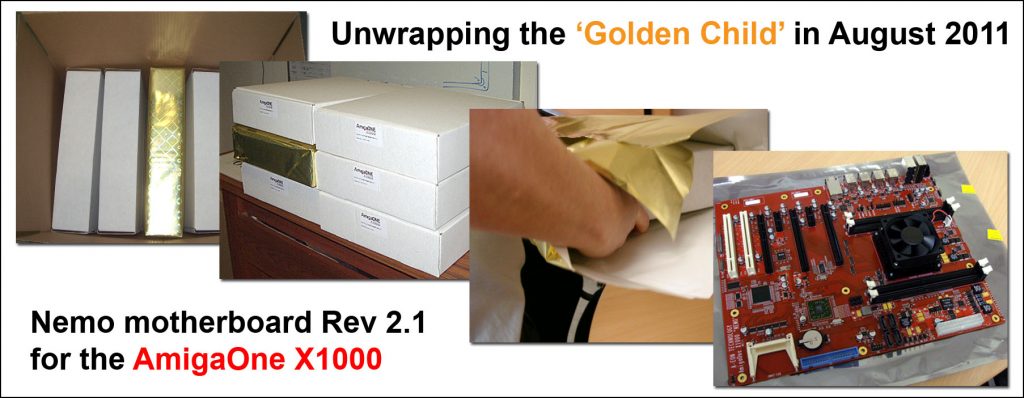 When Christopher Follett, AmigaKit’s technician, opened the shipping carton he discovered that Varisys had wrapped the box containing my board in gold wrapping paper to denote its unique status. He immediately nicknamed my board the Golden Child. AmigaKit installed my Nemo board into a nice Boing Ball modified white Fractal tower case and, for several months, continued to use my X1000 as their in-house test system. Eventually, AmigaKit shipped my system to me in late 2011 just before the AmigaOne X1000 ‘First Contact’ edition was commercially released. Several months after I received my machine, I started having issues with the main case PSU until eventually it died altogether. Fortunately I was able to trace the fault and after a quick soldering job my X1000 was back up and running. My AmigaOne was fully loaded with six HDD’s, a CDROM together with a RadeonHD graphics card, Sound and Ethernet cards as well as a Catweasel Anniversary edition. Every so often I would experience problems with certain devices not recognized on power-up. At the time I put it down to AmigaOS 4.1 beta updates I was installing but when I started to test various PowerPC Linux distributions the problem still occasionally arose. Fast forward to 2018. Actually it’s hard to believe that seven years have passed by so quickly.
When Christopher Follett, AmigaKit’s technician, opened the shipping carton he discovered that Varisys had wrapped the box containing my board in gold wrapping paper to denote its unique status. He immediately nicknamed my board the Golden Child. AmigaKit installed my Nemo board into a nice Boing Ball modified white Fractal tower case and, for several months, continued to use my X1000 as their in-house test system. Eventually, AmigaKit shipped my system to me in late 2011 just before the AmigaOne X1000 ‘First Contact’ edition was commercially released. Several months after I received my machine, I started having issues with the main case PSU until eventually it died altogether. Fortunately I was able to trace the fault and after a quick soldering job my X1000 was back up and running. My AmigaOne was fully loaded with six HDD’s, a CDROM together with a RadeonHD graphics card, Sound and Ethernet cards as well as a Catweasel Anniversary edition. Every so often I would experience problems with certain devices not recognized on power-up. At the time I put it down to AmigaOS 4.1 beta updates I was installing but when I started to test various PowerPC Linux distributions the problem still occasionally arose. Fast forward to 2018. Actually it’s hard to believe that seven years have passed by so quickly.
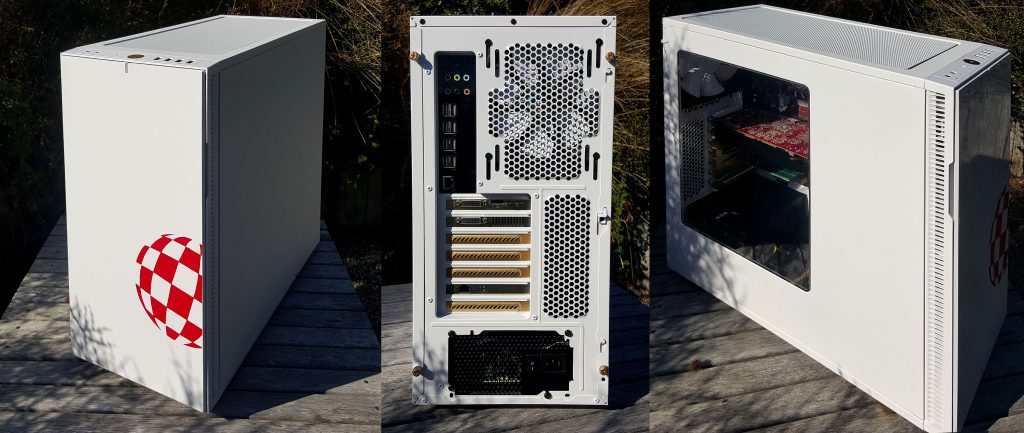
I finally decided to replace that dodgy PSU unit in my X1000 tower. On checking the Fractal website I discovered that they had a special limited edition White and Gold Define R5 tower case for sale. It just had to be. Didn’t the Golden Child, the motherboard that proved the Nemo Rev 2.1 design, just deserve to have that case? 🙂 Fortunately the limited edition case was available to buy in New Zealand so I ordered it along with a new PSU. As soon as it arrived I quickly reassembled my AmigaOne X1000 system and on first power-up she immediately booted to the Workbench screen. I’m pleased to report that all of the previous PSU problems have disappeared and my Golden Child looks really good in her new surroundings. Apparently Nemo can be a girl’s or boy’s name so my AmigaOne X1000 is definitely feminine. 😉 After a couple of weeks of almost continuous use I have to say my AmigaOne X1000 has never performed or looked better! 🙂
Keep talking
The recent death of Dr. Stephen Hawking, the preeminent theoretical physicist, cosmologist, author and all round genius got me thinking about the first time I read his book, A Brief History of Time when it was published in the late 1980s. I read the book twice and could still not get my head around some of his intricate mathematical concepts about life, the universe and everything!  It wasn’t until my wife bought me the illustrated version complete with colour pictures, published in 1996 that a I finally started to understand some of his advanced theories about space and time. 😉 I also remember a very iconic British TV commercial in which Hawkings appeared in the early 1990s to promote BT (the leading UK telecommunications company). The advert was part of BT’s It’s Good to Talk campaign which, while obviously aimed at promoting the company’s business, had it’s central theme that we, as human beings, have accomplished our greatest technological achievements by talking and our greatest failures by not talking. His message was clear, “All we need to do is make sure we keep talking”. The commercial inspired English rock band Pink Floyd to compose the song Keep Talking for their 1994 album, The Division Bell which included Hawking’s distinctive synthesized voice sampled from the BT advert. Pink Floyd again used his voice on the track “Talkin’ Hawkin’ ” in their final studio album, The Endless River, released in 2014. With all the miscommunication and mayhem happening around the word today, we really need to make sure we keep talking, listening and communicating. RIP Stephen, the word will miss your brilliant mind.
It wasn’t until my wife bought me the illustrated version complete with colour pictures, published in 1996 that a I finally started to understand some of his advanced theories about space and time. 😉 I also remember a very iconic British TV commercial in which Hawkings appeared in the early 1990s to promote BT (the leading UK telecommunications company). The advert was part of BT’s It’s Good to Talk campaign which, while obviously aimed at promoting the company’s business, had it’s central theme that we, as human beings, have accomplished our greatest technological achievements by talking and our greatest failures by not talking. His message was clear, “All we need to do is make sure we keep talking”. The commercial inspired English rock band Pink Floyd to compose the song Keep Talking for their 1994 album, The Division Bell which included Hawking’s distinctive synthesized voice sampled from the BT advert. Pink Floyd again used his voice on the track “Talkin’ Hawkin’ ” in their final studio album, The Endless River, released in 2014. With all the miscommunication and mayhem happening around the word today, we really need to make sure we keep talking, listening and communicating. RIP Stephen, the word will miss your brilliant mind.
AmigaOne A1222 update
Talking about communicating, I receive a lot of requests for information about the release date for the AmigaOne A1222. At AmiWest 2017 and Amiga32, in agreement with Hyperion Entertainment, I was able to present the first public showing of the AmigaOne A1222 running a pre-release beta version of AmigaOS 4.1. I was able to demonstrate that AmigaOS4.1 is very stable on the A1222 which also fully supports the latest RadeonHD 3.x, including the new 64-bit VRAM feature, along with Warp 3D Nova and Warp3D-SI. However, I did reveal that work was still ongoing on the Audio and Ethernet drivers and well as FPU optimsation. The A1222 has not been totally cut-off from cyberspace since the AmigaOS 4.1 beta iso included a driver for an inexpensive USB-to-Ethernet device which allowed the A1222 to connect to the web. A number of the beta testers, including me, have been using the device for online access and I even wrote and posted an earlier blog using the device/driver. The USB-to-Ethernet device was a good stop-gap measure but obviously not suitable for the final AmigaOne A1222 release.
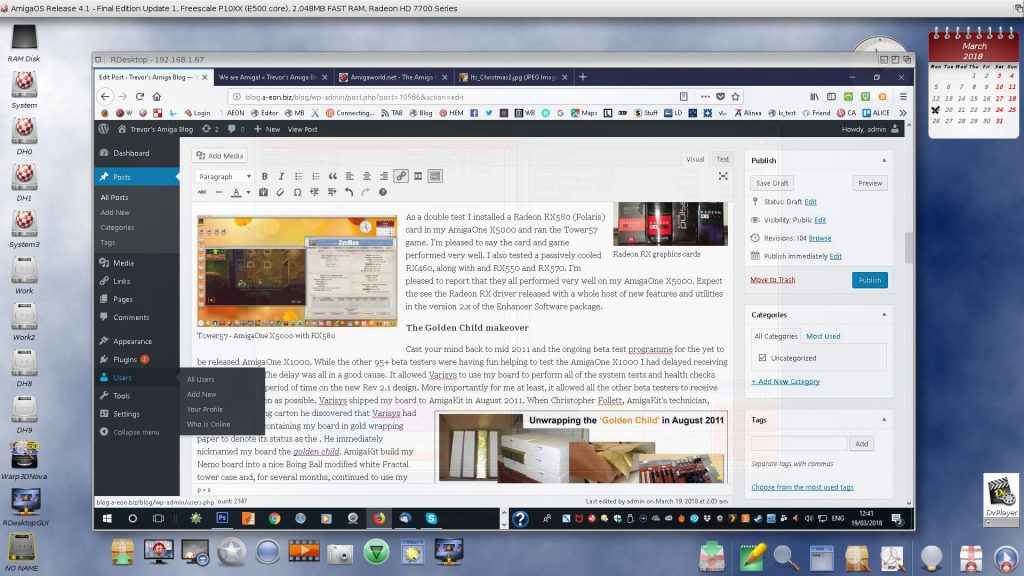
I’m actually writing this blog using a combination Odyssey and Remote Desktop on my AmigaOne A1222 to test out a new on-board Ethernet driver written by AmigaOS 4.1 developer Rene’ Olsen. 🙂 .
I’m pleased to report that Rene’s driver appears to be very stable and works well. I’ve downloaded multiple copies of the latest Enhancer Software v2.x beta archives and installed numerous programs and utilities from AMIStore and transferred gigabytes of data over my LAN without any problems.
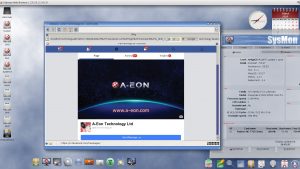
Even better the driver appears to be on par and perhaps a little faster that the standard OS4 network driver for my RTL8139 Ethernet card. Incidentally, Rene’ also wrote the driver for the USB-to-Ethernet device so I suppose it’s no surprise that the initial release of his Ethernet driver works so well. I’ve attached a couple of screengrabs showing Remote Desktop and Odyssey on my A1222, two programs which are always a good tests of network performance. The driver has now been issued to the A1222 beta testers for thorough stress testing. Rene’ received some help from Justin Hibbits who was recommended to Steven Solie by Alex Perez. Alex is another A1222 & X5000 beta tester who has a particular fondness for Linux. Justin is a committer at FreeBSD who, according to Steven, is looking for help with the FreeBSD port. If any Linux motivated A1222 beta testers want to help Justin complete FreeBSD for Tabor/A1222 please make contact and I will pass on your details. We already have the Atlantis and Pathfinder Tabor boards working 24/7 building Debian SPE thanks to the work of John Paul Adrian Glaubitz.
Portable Portia
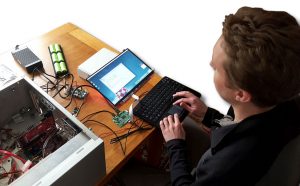
Not only is Hans de Ruiter a graphics wizard, he is also a fully fledged member of the modern maker culture. 😉 Not content with helping to drive AmigaOS graphics development, in his spare time he is working on a special DIY Mini-ITX laptop project. He is using his Tabor beta motherboard as the trial basis for a portable AmigaOne laptop which we have codenamed PORTIA (PORtable Tabor Inspired AmigaOne). Of course, as Amigans you will know that PORTIA was also the name given to the original Ports and Audio custom chip in the very first Amiga. Later its functionality would be expanded and the chip would be renamed PAULA. In true Amiga spirit, Hans is developing his DIY laptop kit for people who enjoy making stuff and who would like to build a laptop from parts they choose themselves.
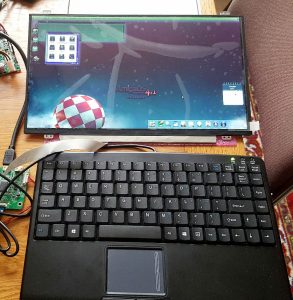
The PORTIA variant is especially for AmigaOS 4.x fans who want a fully-featured portable machine that runs AmigaOS 4.x natively and includes full 3D graphics acceleration via Warp3D Nova 3D which, according to Hans, “will be the fastest path to a true AmigaOS laptop within an acceptable time-frame and cost”. While Hans is in full control of the project, A-EON Technology has agreed to assist him with commercialisation to help minimise the production cost of the DIY kit parts. Hans demoed his proof-of-concept PORTIA prototype at AmiWest 2017 last year.
If you want to find out more about Hans’ DIY laptop project, please visit his Kea Sigma delta website. You can also subscribe to his mailing list to receive regular video updates from Hans as he progresses along his PORTIA journey. His latest video describes his complete redesign of the laptop battery holder.
Into the Blue
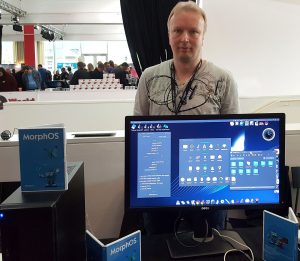
At the AmiWest 2017 and Amiga 32 shows in October last year I saw demonstrations of MorphOS running on the AmigaOne X5000/20. Fresh from a major operation, Paul ‘Acill’ Rezendes still managed to travel to Sacramento to demo a beta version of MorphOS 3.10 on his AmigaOne X5000. He was scheduled to give a presentation on the main screen but unfortunately, due to an incompatibility with his graphics card and the hotel’s AVS, he was unable to use the hotel’s large screen. All was not lost however as Bill Borsari used his hand-held video camera for a closeup one-on-one Paul’s MorphOS demo. A week later in Neuss, Frank Mariak demonstrated the latest beta version of MorphOS running on the X5000. Unlike the traditional MorphOS screen and icons that Paul showed at AmiWest, which date back to 2005, the new version sported a much cleaner and modern look. More importantly, it appeared to run very well on the X5000.
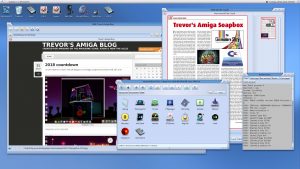
Recently I got the chance to try out the latest beta version of MorphOS 3.10 on my own AmigaOne X5000/20. First of all I had to remove the Radeon HD7970 graphics card that I had installed and replace it with another Radeon HD card that MorphOS fully supports. I tried a couple of cards before settling on an MSI R6670 (HD6670) which seemed to work OK. After that, the installation process was quite fast and painless. I do like the MorphOS CD Live mode that lets you try MorphOS before you install it. The Live mode allows you to set up networking and audio from the CD which enables you to browse the net with OWB or play tunes with Jukebox. A very nice feature indeed. I haven’t had a lot of time to try out MorphOS yet but in general it seems to run very well on my X5000. I don’t know when MorphOS 3.10 will be available for general release so please don’t ask me. 😉
RetCon – retro gaming festival
 If you are going to be in the London area on Saturday 16th of June why don’t you make your way to the Greenford Community Centre to attend the RetConFestival, a retro gaming festival organised by the Greenford Computer Club. Former Commodore UK MD, David Pleasance will be at the show and by that date he should have copies of his book for sale and signing. I will also be attending the show and will be talking about my Commodore and Amiga passion (hey who said obsession?). Tickets are currently on sale through Eventbrite and according to the organiser, Steve Bennett, even at this early stage they are already selling well. So come along and meet David and me and let’s have some Triple-A fun! 😉
If you are going to be in the London area on Saturday 16th of June why don’t you make your way to the Greenford Community Centre to attend the RetConFestival, a retro gaming festival organised by the Greenford Computer Club. Former Commodore UK MD, David Pleasance will be at the show and by that date he should have copies of his book for sale and signing. I will also be attending the show and will be talking about my Commodore and Amiga passion (hey who said obsession?). Tickets are currently on sale through Eventbrite and according to the organiser, Steve Bennett, even at this early stage they are already selling well. So come along and meet David and me and let’s have some Triple-A fun! 😉
….and finally Boing Ball pictures of the week
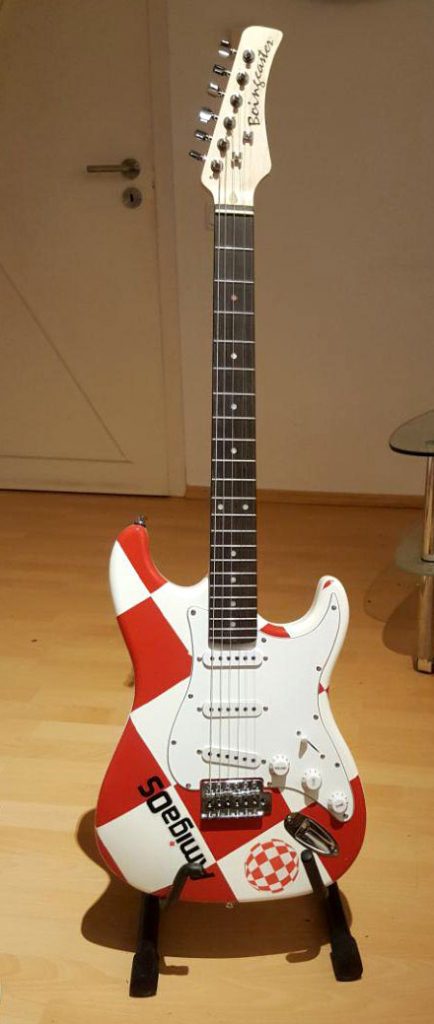
The Boingcaster by Thomas “Rocking” Frieden, our own resident AmigaOS software genius, rock guitarist and artist! Who would have known? 🙂
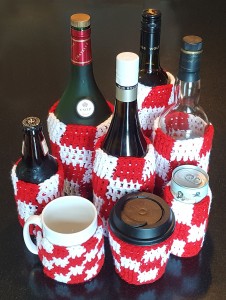
And if that is not enough for you, Jamie Krueger, the owner and developer of BITbyBIT Software Group LLC presented me with a great selection of Boing Ball warmers (or coolers), knitted by his wife, when we met up at AmiWest 2017 in October last year.
Jamie has a very interesting Amiga history and is of course the owner and developer of BITbyBIT Software Group LLC. He is well known for AVD, his SDK Browser for AmigaOS4 and even spent a short time working under under Bill McEwen at Amiga, Inc. What I did not realise is Jamie is also an avid Amiga collector and has a fine collection of Classic and Next-Generation Amiga machines. He was an original AmigaOne X1000 beta tester and is currently working on both the AmigaOne X5000 and A1222 machines. A freeware version of Jamie’s SDK Browser for AmigaOS4 is available on AMIStore for download.
……….until next time